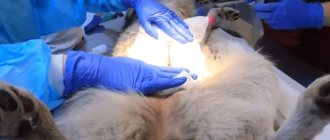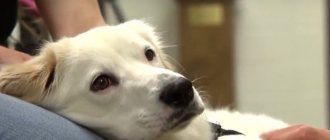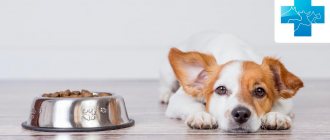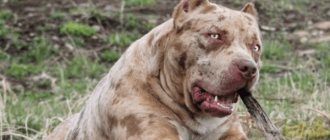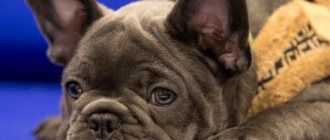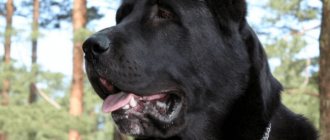Castration is a rather difficult operation for any wet nose. Today we will talk about how to care for a dog after castration, what complications may arise and how to help your beloved pet recover as quickly as possible during this difficult period for him.
Earlier, in the article Castration and sterilization: all the pros and cons, we already considered all the pros and cons of this operation. They talked about whether castration of dogs will help reduce the level of aggressiveness of a four-legged friend and at what age is it better to castrate a tail. They also wrote about the differences between two different concepts: sterilization and castration of an animal.
Our Jack is already 11 years old, and we just recently had him neutered. I explain why we did this at such a respectable age in this video.
We went through this, so I know firsthand about caring for a dog after castration. And today I want to share my experience and tell you what you need to pay special attention to.
See even more interesting and useful material on our YouTube channel.
Preparing for castration
Before we talk directly about care after surgery, I want to give a few recommendations on how to prepare for this procedure:
- First of all, choose a suitable clinic. It is better to do this based on reviews from dog breeders. Choose a clinic closer to home so that transportation is not long and tedious.
- The main danger of the operation is anesthesia. Before castration, it is imperative to consult with a veterinary specialist who will give the necessary recommendations and referrals for examinations regarding the possibility of using anesthesia. The main analysis, of course, is an ultrasound of the heart. During anesthesia, strong drugs are used, and the heart of the tail must be in order.
- Immediately before the procedure, you need to go on a fasting diet. It is recommended to feed adult animals no later than 8-12 hours before surgery. Water is removed from access 4-5 hours before anesthesia.
- So, day X has come. You should not show your worries. Dogs sense our mood very subtly, and excitement can be transmitted to them.
- You have come to the veterinary clinic. Feel free to give your furry friend to the specialists. There is no need to run after, sniffling in the wind, sobbing and wailing.
- As a rule, after castration, the dog is given back to the owner only if the dog has fully recovered, is in good health, and is more or less confidently standing on all its paws.
But even in this case, you must take care of the safe transportation of your four-legged friend.
At what age is this done?
Before you start castrating your dog, you need to know at what age it is best to castrate dogs. It is important that the procedure is easy and with a minimum number of unpleasant consequences that may arise after it.
Note! Many veterinary experts say that a dog can be neutered at almost any age. The main factor to consider is the condition of the animal.
If we are talking about healthy dogs, then castration of an adult cable is quite normal. Often, many owners delay carrying out this procedure; they expect that the pet will calm down by the age of three, and all its physiological needs will go away on their own. In some cases, this happens, especially if increased attention was paid to the upbringing of the animal.
When choosing the age for castration, it is worth taking into account several important factors:
- the most appropriate time for castration is puberty;
- at the onset of puberty, the dog’s body has not yet fully formed, but problems that may be associated with libido have not yet begun;
- It is worth considering that some unpleasant habits may persist even after this procedure, for example, the dog may continue to mark corners. To prevent this, you should carefully monitor his behavior from birth and, if harmful habits appear, immediately take the necessary measures to eliminate them;
- The castration period may depend on many factors. Particular attention should be paid to the breed. Small dogs are neutered earlier - from 7 months, but large dogs later - at a year and a half;
- In order to catch the right moment for castration, special attention should be paid to the behavior of the animal.
It is imperative to choose the right place to castrate your dog. This is an important condition, on which the further successful rehabilitation of the tailed animal will also depend.
The operation can be performed at home; at home, it is much easier and does not cause much stress for the pet.
However, even in a veterinary clinic, the procedure will be safe for the dog’s health, because there are all the necessary equipment and medications that can greatly alleviate the animal’s condition.
If you want your pet to recover faster, then you should pay attention not only to the age of the animal, but also to the process of subsequent rehabilitation. For this reason, it is imperative to provide full care for the male dog after castration.
Find out more about castration of dogs - indications and contraindications, age and methods of implementation.
Transportation after surgery
To ensure that the transportation of the tail from the veterinary clinic is as safe as possible, you should know some important points:
- If the doctor believes that your pet has not fully recovered from anesthesia, looks lethargic and is unwell, then he may be left at the veterinary clinic overnight. Specialists will monitor his condition and provide assistance if necessary.
- But even if the dog runs out to you on its own, you should not put it on a leash to move independently. The anesthesia will leave the body for several more hours and any, even minor, load can cause negative consequences. Moreover, the postoperative suture is still quite fresh.
- If your little dog is small, it is better to pick it up and carry it home.
- If you have a large dog, then you need to organize transportation by car.
- Wrap the animal in a warm blanket or blanket. The fact is that the main goal of general anesthesia is to change the state of the entire central nervous system. And after anesthesia, all systems, all processes in the body slow down. Breathing and blood circulation deteriorate, and the dog can freeze even on the hottest day.
Negative effects of anesthetics
Thanks to the advent of drugs with a gentle effect, the harm from anesthesia is minimized. With the correct dosage and strict adherence to the preparatory steps, no side effects are observed.
Harm to internal organs
In the gas form, harm to internal organs is excluded, since foreign substances are eliminated from the body during breathing. Unpleasant consequences are possible only if there are contraindications. In such cases, the use of anesthetics is permissible only when the possible risks are less than the existing threat.
Contraindications
The use of anesthetic drugs is not recommended in the presence of factors that weaken the body. These include:
- estrus, pregnancy and lactation;
- acute viral infections and chronic diseases of the genitourinary system;
- pathologies of the cardiovascular and respiratory systems;
- old age of more than 10 years.
If the situation involves neglecting the recommendations, the veterinarian must warn about possible complications and risks. In such cases, surgical intervention is carried out strictly after the written consent of the owner.
Caring for your dog on the first day after surgery
Undoubtedly, the behavior of your furry friend on the first day after castration will not be the same as usual. And this is a completely normal reaction. The task of every four-legged owner during this difficult period for everyone is not to panic, but to concentrate as much as possible and provide the animal with proper care for its speedy recovery.
To do this, it is important to know and follow the following recommendations:
- Provide your pet with a comfortable place to rest. After the operation, the animal experiences severe discomfort, pain throughout the body and in the muscles. Therefore, the lounger must be on a flat surface, and preferably on the floor.
- When recovering from anesthesia, all four-legged animals behave very restlessly. Many dogs love to sleep with their owner on the bed. If the bed is on the floor, then at night the pet will most likely try to jump onto your bed. This is very dangerous because if there is a sudden movement, the postoperative suture may come apart. If you decide to immediately put your pet next to you in the bed, then by jumping off the bed, he can also harm himself. Therefore, I recommend organizing your own sleeping place on the floor for the first few days, next to your furry friend. This way he will feel calm and be as safe as possible.
- Your favorite bed should not be in a draft or near a radiator.
- After anesthesia, the animal may experience involuntary urination. Under no circumstances should you blame him for this. Place a sanitary diaper under your dog. Don’t forget to change it on time, otherwise a wet pet may get very cold.
- Don't be alarmed if you notice that the dog is trembling. This is the remnants of anesthesia leaving the body.
- When you come home, put the tail in a bed and cover it with a blanket.
- Under no circumstances should you use a heating pad or other heating devices. This may cause internal bleeding.
- As a rule, the dog sleeps constantly for the first few hours after surgery. At this time, monitor her condition, breathing and the condition of the suture. If an animal lies in one position for a long time, it is recommended to shift it from one side to the other.
- When recovering from anesthesia, the four-legged dog may wander chaotically around the house. Try to jump, jump, climb into some secluded place. Carefully monitor all movements of your tailed friend. This is exactly what happened to us. The first night after the operation, Jack could not find a place to rest. To keep him from harming himself, I had to sacrifice sleep.
- The dog may experience dry eyes for the first few days. To prevent discomfort and moisturize the mucous membranes, you can use special eye drops.
- If the pet does not drink on its own, you should force it to drink using a syringe or large syringe WITHOUT using a needle.
Answer
Usually, dog owners are forced to resort to sterilization to avoid a number of difficulties. First of all, preventing offspring. The instinct for procreation in animals is strong; it is difficult to stop a young lady during heat. Constant dog weddings bore owners and create a new difficulty - the need to accommodate offspring. Especially if we are talking about a mongrel mongrel. Drowning or euthanizing puppies is not the best solution.
In addition, neutering is an effective measure for a number of canine sexually transmitted diseases. Sterilization can protect your pet from mammary cancer, pyometra, and sarcoma.
Suture after surgery
In the postoperative period, it is important to monitor the condition of the quadruped suture. The seams of males and females are very different from each other. In males, the seams are relatively small. When castration and sterilization of bitches, a large incision is made, so caring for the seam is much more difficult.
In modern medicine, self-absorbable threads are being used more and more often. Therefore, there is no need to remove them. But still, the veterinarian should tell you what threads were used, whether they should be removed, and the peculiarities of processing sutures after surgery.
Stitches in a male dog
As a rule, the suture of a male dog after castration does not require additional processing. You just need to monitor it, and only if it becomes infected or gets wet, contact a veterinarian and take the necessary measures.
With normal recovery, for 5-7 days the male dog may only experience swelling in the scrotum area. This is due to the accumulation of lymph. You shouldn't worry about this. This is a normal protective reaction of the body.
The bitch has stitches
Caring for postoperative sutures in bitches requires more effort. The incision is quite large, so swelling and swelling may often appear.
The treatment procedure does not cause the dog any particular inconvenience or pain. To avoid drying out the skin, it is best to treat the area around the seam with an alcohol-free antiseptic composition. You can use 3% hydrogen peroxide. Wipe all skin folds and the seam itself along the edge, removing dried ichor. It is not advisable to wipe the surface of the seam itself. Only if heavily soiled. It is better to apply antibacterial wound-healing ointments, such as Levomekol, directly to the wound.
What should you be wary of?
If swelling, swelling, redness, an unpleasant odor, blood, or pus appear in the suture area, contact a veterinarian immediately.
When is anesthesia necessary?
The main task of anesthesia is not pain relief at all - analgesics cope with this problem. Despite the absence of pain, a four-legged patient is unlikely to tolerate drilling a tooth or interfering with its internal organs. Fear makes the behavior of animals completely unpredictable, so doctors try to limit their activity for mutual safety. Therefore, anesthesia sleep is immobilization, not pain relief.
The main indications for the use of anesthetics include:
- surgeries on limbs and internal organs;
- unpleasant cosmetic and diagnostic procedures;
- severe stress or uncontrolled aggression on the part of the patient.
Additionally, muscle relaxants are introduced into the body to relax the muscles. Throughout all manipulations, the state of the body is monitored by special sensors that trigger ventilation in an emergency.
Blanket or protective collar
After castration surgery, in order to avoid licking the wounds, the animal is recommended to wear a protective collar. For male dogs this is quite enough.
By the way, you can sew such a soft, comfortable protective collar for your pet yourself, in which your tail will be as comfortable as possible. It is sewn very simply and quickly.
You can see how to do this in the material: Comfortable soft postoperative collar for a dog or cat.
But in bitches the seam surface is much larger. Therefore, they additionally need to use a postoperative blanket. The rules for wearing it are very simple:
- The blanket should be changed approximately once a day.
- In order to eliminate existing bacteria as much as possible, before each use the blanket should be washed well and ironed with a hot iron.
- There is no need to remove the blanket when processing seams. It is enough to untie a few straps.
Toilet care and exercise
The first days after castration, limit physical activity. Our Jack, for example, already on the second day began to bring me balls and toys and demanded active games. This is absolutely impossible to do. With sudden movements, the seams may come apart.
Street walking should also be reduced. Take your dog out for literally 5-10 minutes only to relieve his toilet needs. If the dog is wearing a diaper, walks outside can generally be postponed for several days.
Nutrition
A balanced and healthy diet is an important component of a speedy recovery.
It is not recommended to feed the animal for the first day after surgery. The swallowing reflex is still very weak and food can enter the bronchi, which can lead to a lack of oxygen, difficulty breathing and death.
When your pet fully regains consciousness, you can give him clean drinking water.
The dog's nutrition after castration should be correct:
- Food should be low-fat and fairly “light”, dietary.
- The four-legged animal should be fed in small portions.
- If the dog strains during defecation, the stitches may come apart.
- You should not be concerned if the tail does not completely eat the offered portion.
- Many animals lose sexual interest after castration and find joy in food. To avoid obesity, you should review your diet. Remove too high-calorie foods from it and reduce the serving size.
How to carry out sterilization
The surgical intervention is performed by a veterinarian under general anesthesia.
The duration of the operation is approximately one and a half hours. The method of sterilization depends on the gender of the dog. With males the situation is simpler - the surgeon removes the seminal glands using a number of surgical options. It's more difficult with females. Any type of sterilization involves surgical intervention with access to the inside of the abdomen. Through the access, either the dog’s uterus and ovaries are cut out, or only the ovaries.
For male puppies, the procedure is recommended to be performed upon reaching six months of age. If carried out earlier, the maturation and growth of the animal may be delayed. For females, it is better to perform the intervention before the first empty nest appears. The optimal age is 4-5 months. The measure allows you to reduce the risk of developing cancer in your pet by 200 times. The later the operation is performed, the higher the risk of tumor development becomes.
Possible complications
Despite the fact that castration of a dog is considered the simplest surgical intervention, complications can still arise after it:
- Decreased or complete loss of appetite.
- Problems with bowel movements, constipation. In this case, you should reconsider your diet.
- Drowsiness, weakness.
- Disorientation in space.
- Nausea.
As a rule, all of the above symptoms go away on their own. But if you have the following signs of illness, you should immediately contact a veterinarian:
- Suture rupture, inflammation and suppuration of the wound.
- Temperature increase.
- Pain when moving.
- You should be wary if the dog constantly lies down and does not get up.
- Urinary incontinence in the days following surgery.
- A bluish color of the skin in the wound area is a sign of internal bleeding.
- Severe swelling in the suture area.
Scrotal swelling
If there are no medical indications, then the scrotum is not removed during castration of a male dog. Immediately after surgery, this leather pouch remains empty. Doctors may briefly apply a heating pad with ice to the scrotum to cause the blood vessels to constrict.
Don't worry about the aesthetic side of the issue - in a few months the skin will magically tighten. There will be a smooth place where the testicles were.
Bulldog after castration
True, this takes time. But the body does not tolerate any emptiness and strives to fill it. Therefore, lymph can accumulate in the scrotum. On the third or fourth day, it looks as if the testes have returned to their place! This is fine.
Sometimes the swelling can be too strong and painful. This happens in several cases:
- Blood clots had accumulated in the scrotum because a vessel was damaged and not ligated.
- The wound became infected and inflammation began.
- Rejection of the suture material occurs (the latter situation is extremely rare; usually the problem is a violation of sterility).
In which case should you see a veterinary surgeon as soon as possible:
- the scrotum is purple or bluish in color;
- the swelling is so strong that the scrotum is larger in size than before the operation, the skin is stretched;
- discomfort when walking in a dog, signs of pain.
The doctor may prescribe novocaine blockades with an antibiotic or systemic antibiotics; sometimes surgical revision of the wound is required (under local anesthesia).
This Labsky (Labrador and Husky mix) was neutered at 7 months.
You can see more photos of Labski HERE (link will open in a new tab)
Working qualities
If your dog is a guard or hunting breed, it is important to know how its working qualities will change after castration surgery:
- If you regularly take your pet hunting, you should think carefully about castration. After all, an animal may lose interest and excitement when hunting prey.
- But as far as security qualities are concerned, there is nothing to worry about. The protective instinct in dogs does not disappear after castration.
Each dog owner decides for himself whether to castrate his pet or not. Any trip to the veterinary clinic, any operation is a huge stress not only for a furry friend, but also for every loving owner.
But if you provide proper care for your dog after castration, then both you and your dog will quickly and without complications go through this difficult rehabilitation process together. Good luck and take care of your pets!
Veterinarian advice
In order for your pet’s rehabilitation to go without complications, it is a good idea to consider the following recommendations:
- You need to choose a clinic for surgery carefully. How the procedure goes and how quickly the dog recovers depends on its equipment and the professionalism of the doctor.
- Castration at home is not the best option, even if performed by a veterinarian. Only the clinic has the necessary equipment that may be needed in case of unforeseen complications.
- You need to weigh the pros and cons of surgery for a particular animal.
- Advice is given by experts for the benefit of the dog, so its implementation is mandatory.
- If the veterinarian has prescribed drug support for the rehabilitation period, do not forget about the timely administration of drugs.
- The pet’s well-being is monitored until its final recovery. If alarming signs appear, it is better to consult a specialist.
- Dogs are asked to go for walks already on the 3rd day after surgery. You can go out, but not for long, taking care to protect the seam. For the first 2 weeks, active walks with running and jumping should not be allowed.
To castrate your animal or not - each person decides for himself. Any operation is stressful for the pet. But if the owner provides the dog with proper care after castration or sterilization and follows all the veterinarian’s instructions, the rehabilitation process will be quick and painless for the animal.
